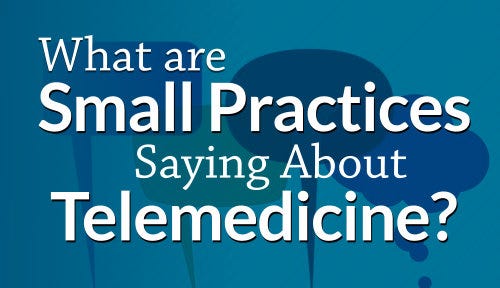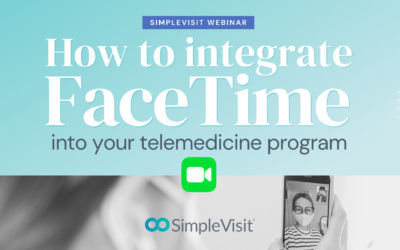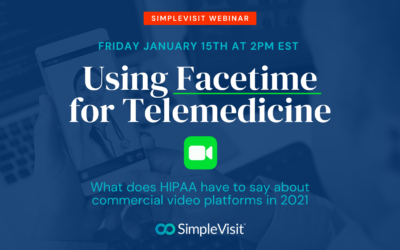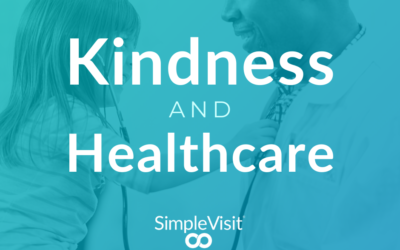
What Are Small Practices Saying About Telemedicine?
While leaders in healthcare are pushing for an era of digital care, many providers on the frontlines have remained silent observers. In a recent field survey, the SimpleVisit team explored the impact of telemedicine in four types of small practices located across the U.S. The survey was distributed among the four practice types which were identified as highly likely to be using telemedicine services: primary care, psychiatry, house call only, and concierge care doctors. Phone interviews of staff and practitioners were conducted to dig into the rate of usage, and to discover which patient demographics benefitted the most from telehealth. All practices interviewed were independent practitioners in a practice of 10 or fewer total providers.

Family Practice
The first provider segment interviewed were family practitioners, who have been viewed by many as a champion of telehealth and the first layer of healthcare for most patients. Telehealth feels like a natural fit for family practitioners, who must screen patients quickly and make a variety of diagnoses. It was discovered that a majority of generalists interviewed view telehealth as a key asset for elderly care. However, despite a clearly identified need, less than 20% of providers interviewed currently offered their patients video visit services. While a minority did offer telemedicine services such as phone calls, texting, emailing, and E-prescribe, willingness to try video visits was limited.
House Call Only
The second category analyzed was providers who primarily offer house call services to patients. A fleeting concept, the house call was once the dominant mechanism of healthcare delivery in America. Considering the new age house call, telemedicine appears to be a natural fit for providers who stand behind convenient care. Surprisingly, house call doctors had one of the lowest rates of adoption amongst the provider types surveyed. When questioned about why they would not adopt telemedicine technology, the most common answer was “I don’t find video visits as capable of doing everything I need for my patients during a visit”. While some cases did require special attention, over 80% of house call providers said that homebound elderly patients receiving routine maintenance would benefit from telemedicine technology. There appears to be a likely disconnect between the limitations of telemedicine and the services patients in this segment are in need of during a visit.
Concierge Care
Reimbursement is often indicated as a major barrier to telemedicine implementation. With this in mind, SimpleVisit wanted to study how concierge, or capitation and cash based practices are utilizing telehealth. Rates of interest in telemedicine utilization did not fall outside the expected range in comparison to all other practice types. Many concierge practices indicated small patient bases who expected a high level of quality in their care as the biggest barrier to engaging in telehealth. Over 50% of the practices that we interviewed identified that few of their patients would benefit from virtual care, and utilization among practices engaging in telehealth was extremely rare. The perception of reduced quality of care as a result of video visits seems to be a common misconception amongst practice types who choose to operate outside the conventional practice style of high visit volumes with insurance reimbursement.
Psychiatry
The last segment surveyed were psychiatry practices. Psychiatry is often seen as the ideal use case for telehealth, as visits can be simulated with audio and visual video communication without a reduction in provider capabilities,. This has lead to the successful early adoption of telepsychiatry in many large healthcare institutions. While psychiatry practices reflected the highest percentage of interested practitioners, adoption rates were similar to the other segments interviewed at 15–20%. Unique to this segment however was the focus on young, tech savvy patients as the biggest beneficiaries of telehealth. This perhaps reflects the rising trend of mental health utilization among younger demographics who are willing to receive remote video care. The low rates of adoption despite a clear patient base who would utilize video visits in this segment is quite perplexing. It perhaps is reflective of a segment which is amidst a transition, but who is uncertain on how to progress.
Conclusion
Based on the results of the field study, there remains surprisingly low adoption rates regardless of the type of practice. 75% of doctors recognize that a portion of their patient base would benefit from telemedicine. Yet the same group reported about 17% in current implementation. The patient segment most often identified as benefiting from telehealth was elderly patients who struggle to make it in for regular appointments. Perhaps the rise in telehealth is coming for small practice providers, but we are still in the early phases of this adoption.
For more insights on telemedicine implementation for small practices, message info@simplevisit.com or call 877.838.4748.
About SimpleVisit
SimpleVisit is a video service which allows patients and providers to connect over the video platform of their choice. With SimpleVisit providers are able to deliver on-demand visits to patients over any device or platform they have available to them. For more information on SimpleVisit and on how we are enabling providers to host virtual visits check out www.SimpleVisit.com
How to Integrate FaceTime for Telemedicine
Rob Warlick | 3 min read | April 23, 2021During the public health emergency, direct FaceTime calls are permitted for healthcare. Outside of that waiver, SimpleVisit is the only HIPAA-compliant way to bridge in FaceTime and other video calling apps. With over 620...
Using FaceTime for Telemedicine in 2021
Rob Warlick | 4 min read | January 26, 2021 In response to the global pandemic and the public health emergency, many medical groups have purchased or crafted a solution to treat over video. Due to the lax in federal regulations, many are turning to commonly available...
Kindness and Healthcare
Allie Clark | 10 min read | December 2, 2020It is time for some kindness. The holiday season can be a rough time for many among us. A report from the National Alliance on Mental Illness shows that this time of the year negatively affects a majority of people suffering...



